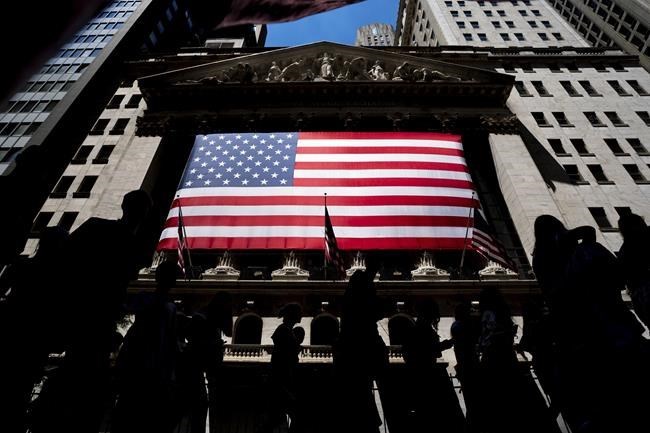NEW YORK (AP) — Stocks ended mixed on Wall Street following several sharp reversals after a report suggested inflation may not be slowing as quickly and as smoothly as hoped. The S&P 500 closed virtually unchanged Tuesday after swinging between losses and gains throughout the day. The Nasdaq composite rose 0.6% and the Dow fell 0.5%. The bond market was more decisive, with yields climbing as investors braced for the Federal Reserve to get firmer on interest rates to combat inflation. Analysts said the report shows the long road ahead for the Fed in getting inflation down to its 2% target.
THIS IS A BREAKING NEWS UPDATE. AP’s earlier story follows below.
NEW YORK (AP) — Stocks are mixed on Wall Street Tuesday following several sharp reversals after a report suggested inflation may not be slowing as quickly and as smoothly as hoped.
The S&P 500 was virtually unchanged in late trading after swinging between losses and gains throughout the day. The bond market was more decisive, with yields climbing as investors braced for the Federal Reserve to get firmer on interest rates to combat inflation.
The Dow Jones Industrial Average was down 104 points, or 0.3%, at 34,135, as of 3:05 p.m. Eastern time. The Nasdaq composite was 0.4% higher after earlier ricocheting between a loss of 0.9% and a gain of 1.1%
The report was so hotly anticipated because inflation and the Federal Reserve’s response to it have been at the center of Wall Street’s struggles for more than a year. Inflation has been cooling since a summertime peak, and investors are trying to guess how quickly and smoothly a decline could happen to the Fed’s 2% target.
Tuesday’s report showed that inflation slowed to 6.4% in January from its peak of 9.1% in June. The hope on Wall Street has been for a continuing slowdown to get the Federal Reserve to pause its hikes to interest rates and perhaps begin contemplating cuts to them.
High rates can drive down inflation but also raise the risk of a severe recession and hurt investment prices. The Fed has already hiked its key short-term rate to a range of 4.50% to 4.75%, up from virtually zero a year ago.
Nearly half of January’s month-over-month inflation came from an area where Fed Chair Jerome Powell has said he sees easing pressure in the pipeline: housing and other shelter-related prices.
But on the downside for markets, the improvement in inflation wasn't by as much as economists expected. That could encourage the Fed to be more aggressive on interest rates than it’s been saying. The Fed has indicated it envisions at least a couple more increases before holding rates at a high level for a while.
“While inflation is heading in the right direction, there is a long and bumpy road ahead to price stability,” said Andrew Patterson, senior economist at Vanguard.
Even after ignoring the effects of prices for food and energy, which can swing more sharply than others, what's called “core inflation” was still slightly higher than expected last month.
Such strength “suggests that the Fed has a lot more work to do to bring inflation back to 2%,” said Maria Vassalou, co-chief investment officer of multi-asset solutions at Goldman Sachs Asset Management. “If retail sales also show strength tomorrow, the Fed may have to increase their funds rate target to 5.5% in order to tame inflation.”
Investors have been raising their forecasts for how high the Fed will take rates by the summer, and they’re now betting on a 20.3% probability that its key rate will top 5.5% in July. That’s up from just a 0.2% probability seen a month ago, according to CME Group.
In the end, several analysts said Tuesday’s inflation report confirms a cooling trend but doesn’t answer any big questions by itself.
“This inflation print served as a reminder to investors that the path to lower inflation is not as clear cut as previously thought and it is too early for the Fed to declare victory on inflation,” said Gargi Chaudhuri, head of iShares Investment Strategy, Americas.
The market’s expectations for the Fed have been driving yields higher in the bond market in particular. The two-year Treasury has shot to its highest level since November, egged on last week after a stronger-than-expected report on the U.S. jobs market.
The two-year yield jumped to 4.63% from 4.52% late Monday. It initially zig-zagged up, down and back again after the release of the inflation report.
The 10-year yield, which helps set rates for mortgages and other loans, rose to 3.76% from 3.70%.
All the worries about inflation and rates are hanging over the market that's already contending with a relatively lackluster earnings reporting season. Companies have been reporting weaker results as higher costs and interest rates eat into their profits.
Restaurant Brands International, which operates Burger King and Tim Hortons restaurant, fell 3.2% after reporting weaker earnings than expected.
Avis Budget Group, meanwhile, jumped 10% after easily topping analysts’ profit forecasts.
___
AP Business Writers Damian J. Troise, Yuri Kageyama and Matt Ott contributed.
Stan Choe, The Associated Press



